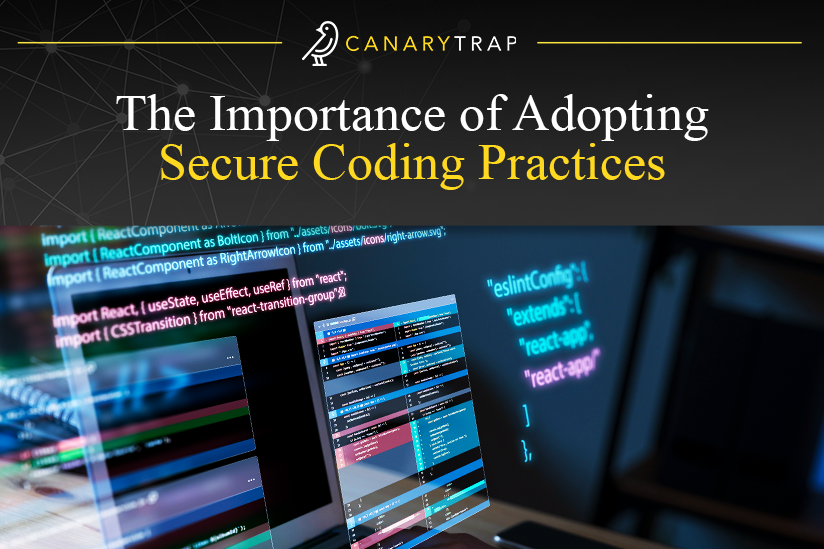Best Practices for Safer Software Development
- June 1, 2023
- Canary Trap
In our hyper-connected digital world, where a single piece of code can significantly impact millions of lives and businesses, secure coding has become a necessity, not just an option. Secure coding refers to the practice of writing software in a way that guards against the introduction of security vulnerabilities that could be exploited by attackers.
It’s about taking a proactive approach to software development, with an understanding that every line of code could potentially become a weak link in the security chain. It’s not just about fixing bugs or patching vulnerabilities; it’s about designing and developing software that is resilient to threats right from the get-go.
The importance of secure coding cannot be overstated, and the consequences of insecure coding can range from data breaches and financial loss to reputational damage and loss of customer trust. On the other hand, secure coding practices can enhance data protection, maintain application integrity, prevent unauthorized access, and ultimately foster trust in digital systems. Therefore, understanding and implementing secure coding practices is paramount for developers, security professionals, and organizations in today’s cybersecurity landscape.
Input Validation
Input validation serves as the first line of defense in secure coding. It’s the process of ensuring an application correctly checks the input data provided by a user before processing it. In an unsecure coding scenario, an attacker could manipulate the application by injecting malicious data.
SQL Injection attacks, for instance, are some of the most common. According to Bright Security, “SQLi attacks allow attackers to modify database information, access sensitive data, execute admin tasks on the database, and recover files from the system. In some cases attackers can issue commands to the underlying database operating system.”
Key Approaches
There are two key approaches to input validation: whitelisting and blacklisting. Whitelisting allows only specific types of input and rejects everything else. On the other hand, blacklisting rejects specified types of input while accepting everything else. For instance, an application could be programmed to reject any input containing database commands. However, due to the sheer volume of potential malicious inputs, blacklisting is generally less secure than whitelisting.
Effective input validation can prevent a wide range of vulnerabilities, including SQL injection, cross-site scripting (XSS), and command injection. By ensuring that only valid and safe input is processed, developers can significantly reduce the risk of security vulnerabilities being exploited.
Principle of Least Privilege
The Principle of Least Privilege (PoLP) is a computer security concept in which a user, program or system process is granted the minimum levels of access, or permissions, needed to complete its legitimate tasks. In essence, under PoLP, every module (such as a process, a user, or a program depending on the subject) should have the least authority necessary to perform its duties. This minimizes the damage that can result from errors or malicious intent.
PoLP applies not just to users but also to applications and systems. For example, a web application should not have the ability to alter files in the system or interact with the database beyond what is absolutely necessary for it to function.
As stated by Heimdal Security “the danger of unintentional insider threats can always exist inside your organization. This means that some employees may unknowingly do harm by clicking on phishing links or following instructions received from imposters.”
That’s why by adhering to the principle of least privilege, developers can create a more secure coding environment, reduce the risk of a data breach, and minimize the potential damage in the event of a breach.
Secure Defaults
When it comes to designing and implementing software systems, establishing secure defaults is a vital practice. Secure defaults ensure that if a user or administrator fails to configure security settings appropriately, the system will still operate with a high level of security.
Secure defaults also extend to feature availability. Features that could potentially be exploited for malicious purposes should be disabled by default, only being enabled when necessary and by a user with appropriate privileges. An example might be certain types of network access or permissions to execute system commands.
The goal is to ensure that security doesn’t rely on the user making the right choices. Even the most security-conscious users can make mistakes or overlook certain settings, so it’s crucial to have a safety net in place. By implementing secure defaults, developers can help protect both the users and the system, even in scenarios where security isn’t properly configured.
Error and Exception Handling
One often overlooked aspect of secure coding is proper error and exception handling. When an application encounters an unexpected situation, such as invalid input or a failed operation, it will typically throw an error or exception. How these situations are handled can have significant implications for security.
A common mistake in error and exception handling is revealing too much information in error messages. For instance, a detailed error message might reveal the internal workings of an application or provide hints about its database structure. This information could be a goldmine for attackers, providing them with valuable insights they could use to exploit the system. To mitigate this, error messages shown to users should be generic, while detailed error information should be logged for internal use and debugging.
Code Reviews and Security Audits
Regular code reviews and security audits are critical components of secure coding practices. These processes involve a thorough examination of the source code and overall system to identify potential security weaknesses and to ensure adherence to security standards.
Code reviews involve developers examining each other’s code. This peer review process is beneficial for several reasons. Firstly, it allows for the detection of potential security issues that the original developer may have overlooked. Secondly, it promotes knowledge sharing among the team, spreading awareness of potential security pitfalls and the best ways to avoid them.
Security audits, on the other hand, are usually more formal and comprehensive. They involve a detailed examination of the system to assess its security posture. This could be performed by an internal security team or an external organization specializing in security audits. An audit can identify vulnerabilities, assess risk levels, and ensure compliance with relevant security regulations and standards.
Both code reviews and security audits should be performed regularly. This helps to catch issues early in the development cycle, when they are generally easier and less costly to fix. Regular reviews and audits also help ensure that security is continuously maintained as the software evolves and new potential vulnerabilities emerge.
Use of Cryptography
Cryptography plays an essential role in secure coding, especially when dealing with sensitive data. It provides mechanisms for data confidentiality, integrity, and non-repudiation, and is often used for secure storage and transmission of data.
However, cryptography is a complex field with many potential pitfalls. Even small mistakes in the implementation of cryptographic algorithms can lead to significant vulnerabilities. For this reason, it’s crucial for developers to rely on proven, extensively tested cryptographic libraries and algorithms rather than attempting to create their own.
It’s also important to consider the specific requirements of the data and the system when choosing cryptographic methods. For example, some types of data may require both encryption (for confidentiality) and a digital signature (for integrity and non-repudiation), while others may only require one or the other.
By properly using cryptography, developers can significantly enhance the security of their code and protect sensitive data from unauthorized access or tampering.
Secure Session Management
In web development, managing user sessions securely is a critical part of secure coding practices. When a user logs into a web application, a session is created to maintain the user’s state between different page requests. If not handled securely, these sessions can become a potential attack vector.
Security experts at Norton detail that “a session hijacking attack happens when an attacker takes over your internet session — for instance, while you’re checking your credit card balance, paying your bills, or shopping at an online store. […] A session hijacking attacker can then do anything you could do on the site” to fool the website into thinking it’s you.
Another aspect of secure session management is ensuring that sessions expire after a period of inactivity. This can prevent an attacker from using an old session if they manage to obtain a session identifier.
Software and Library Updates
Keeping software and libraries up-to-date is a crucial part of secure coding. Outdated software and libraries can often become security liabilities, as they may contain known vulnerabilities that attackers can exploit. When a vulnerability is discovered in a piece of software or a library, the maintainers will typically release a patch to fix it. However, this patch can only protect your application if it’s applied.
It’s not uncommon for developers to use third-party libraries to speed up development and add functionality to their applications. While these libraries can be beneficial, they can also introduce vulnerabilities if they’re not kept up-to-date. Therefore, it’s essential to have a process in place for regularly updating your software and libraries.
It’s also important to remove any unused software or libraries, as they can present unnecessary security risks. This practice, known as “software minimization” or “reducing attack surface,” can significantly improve the security posture of your application
Continuous Improvement and Adaptation
In the ever-evolving world of technology and cybersecurity, it’s essential to recognize that secure coding practices are not a one-time effort but an ongoing process of continuous improvement and adaptation. As new threats and vulnerabilities emerge, developers must stay informed and update their coding practices accordingly.
As was noted in an article by Orient Software “secure software development is a journey that never ends.“ That’s why organizations and individuals “should always look for new ways to improve and make codes more secure as technology evolves and hackers find new types of attacks to exploit against Software vulnerabilities.”
To ensure continuous improvement, developers and organizations should regularly evaluate and update their secure coding guidelines and practices, taking into account the latest industry standards, emerging threats, and lessons learned from past incidents. This may involve adopting new tools, libraries, or frameworks that offer better security, as well as revisiting older code to ensure it complies with current security standards.
In Conclusion
It is essential to embrace a culture of learning and sharing within the development team. Encourage developers to share their experiences, knowledge, and insights about secure coding, and promote a collaborative approach to tackling security challenges. This not only helps to keep everyone informed and up-to-date but also fosters a collective sense of responsibility for the security of the software.
In summary, secure coding is an ongoing journey. By continually evaluating and adapting secure coding practices, developers and organizations can stay ahead of evolving threats and ensure the highest possible level of security for their applications and systems.
SOURCES:
- https://brightsec.com/blog/sql-injection-attack/
- https://heimdalsecurity.com/blog/what-is-the-principle-of-least-privilege-polp/
- https://us.norton.com/blog/id-theft/session-hijacking#:~:text=is%20session%20hijacking%3F-,A%20session%20hijacking%20attack%20happens%20when%20an%20attacker%20takes%20over,shopping%20at%20an%20online%20store.
- https://www.orientsoftware.com/blog/software-development-security/

